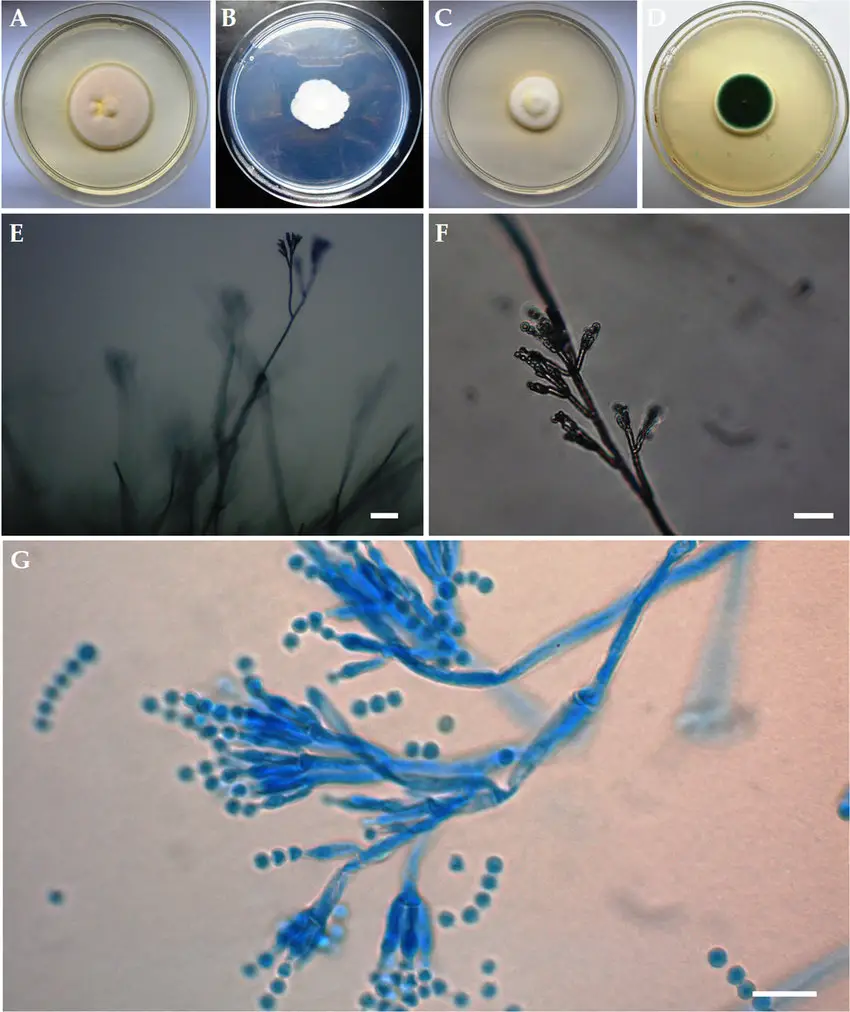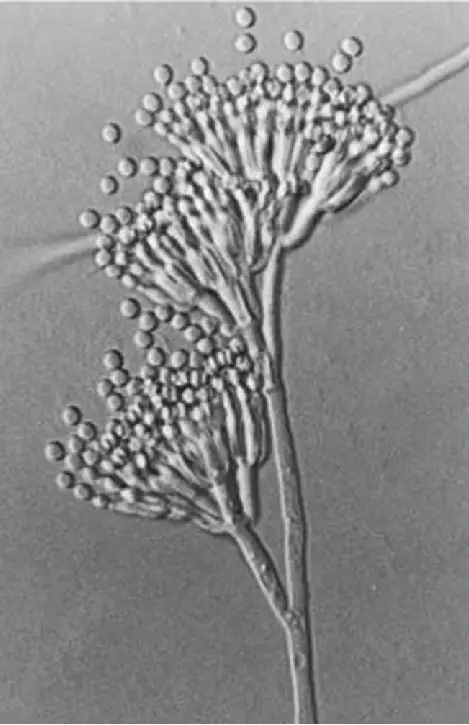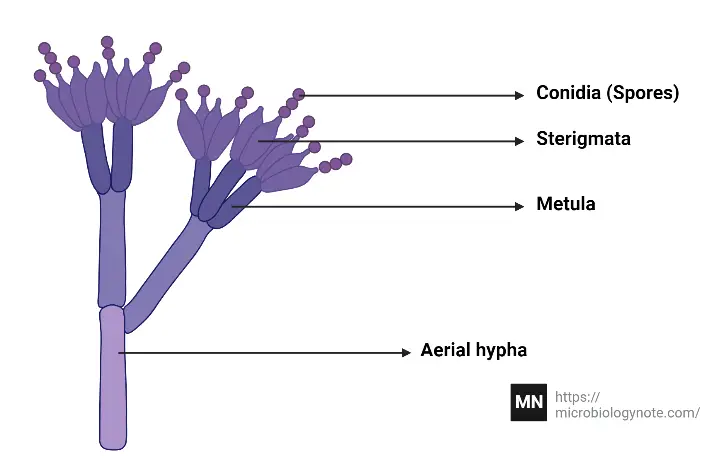Table of Contents
| Kingdom: | Fungi |
| Division: | Ascomycota |
| Class: | Eurotiomycetes |
| Order: | Eurotiales |
| Family: | Trichocomaceae |
| Genus: | Penicillium |
| Species: | P. chrysogenum |
- The fungus Penicillium chrysogenum belongs to the genus Penicillium.
- It is prevalent in temperate and subtropical regions and can be found on salted food products, but it is primarily found indoors, particularly in moist or water-damaged structures.
- A species complex comprising P. notatum, P. meleagrinum, and P. cyanofulvum has been identified.
- The first penicillin-producing strain discovered by Alexander Fleming is of a distinct species, P. rubens, and not P. notatum.
- It has rarely been reported as a human disease-causing agent.
- P. chrysogenum is the origin of a number of -lactam antibiotics, most notably penicillin.
- Roquefortine C, meleagrin, chrysogine, 6-MSA, YWA1/melanin, andrastatin A, fungisporin, secalonic acids, sorbicillin, and PR-toxin are additional secondary metabolites of P. chrysogenum.
- Typically, P. chrysogenum reproduces by producing desiccated chains of spores (or conidia) from bristle-shaped conidiophores.
- The conidia are typically transported to new colonization sites by air currents.
- The conidia of P. chrysogenum are blue to blue-green, and the mold can occasionally exude a yellow pigment.
- Observations of morphology and microscopic characteristics are necessary to confirm its identity, and DNA sequencing is required to differentiate it from closely related species such as P. rubens.
- In 2013, the sexual stage of P. chrysogenum was discovered by mating cultures in the dark on oatmeal agar supplemented with biotin, after determining the mating types of the strains using PCR.
- P. chrysogenum’s airborne asexual spores are significant human allergens.
- Industrial uses of P. chrysogenum include the production of penicillin and xanthocillin X, the treatment of pulp mill residue, and the production of polyamine oxidase, phosphogluconate dehydrogenase, and glucose oxidase.

Characteristics and significance
- Penicillium chrysogenum is an extensively researched species of the genus Penicillium.
- It is also known as P. notatum, P. meleagrinum, and P. cyaneofulvum, although these names are not always interchangeable.
- Penicillium chrysogenum plays an important role in the medical community as an antibiotic due to its ability to produce penicillin, which inhibits the biosynthesis of bacterial cell walls, thereby causing cell lysis.
- It can also serve as a pathogen, allergen, and a potential crop protector against certain pathogen attacks.
- Alexander Fleming initially discovered Penicillium.
- Penicillium chrysogenum is a prevalent fungus that inhabits a variety of habitats, such as the soils of degraded forests, the pollen and provisions of alfalfa leafcutter bees, and the sediment-rich basal ice shelves of Arctic subglacial ice, where it feeds.
- The mycorrhizal fungus Penicillium chrysogenum is typically found in saturated soils containing abundant amounts of carbon and nitrogen.
- This species is also present on decaying produce.
- It is evident that sequencing the genome of Penicillium chrysogenum is crucial.
- It plays a significant role in the lives of humans in various forms, including pathogen, allergen, and most importantly, industrial source of antibiotics.
- Understanding the various metabolic and biosynthetic systems of Penicillium chrysogenum will enable researchers to limit its growth when it acts as a pathogen, reduce the allergic response to it when it acts as an allergen, or maximize the biosynthesis of penicillin when it is used to manufacture the antibiotic.
- When contemplating the emergence of new drug-resistant bacterial strains, it is also crucial to possess the genome sequence of this species for analysis purposes.
- Penicillium chrysogenum typically begins as a white, powdery mass that later turns green and then black, and a yellow color that diffuses throughout the medium appears after several days.
- Observations of the species’ morphology and microscopic characteristics are sufficient for identification, but DNA sequencing is required to distinguish it from closely related species such as P. rubens.

Habitat of Penicillium chrysogenum
- Penicillium chrysogenum is a very adaptable fungus that can grow well both indoors and out. This fungus thrives in humid environments or those that have been damaged by water. It can cause structural damage to homes and structures if left untreated and is commonly seen growing on damp building materials like drywall, carpet, or wallpaper.
- Penicillium chrysogenum is not only common inside, but also in subtropical and temperate zones. As a key component in decomposing organic matter and recycling soil nutrients, it is commonly found in wet soil and damaged forest vegetation.
- Penicillium chrysogenum is a saprophytic fungus, meaning it thrives on dead or decaying organic waste. This encompasses everything from decaying plants and animals to insects that have fallen to the ground. It can contaminate grains, nuts, and other preserved foods if necessary precautions are not taken.
- The bodies of alfalfa leafcutter bees are an intriguing habitat for Penicillium chrysogenum. Penicillium chrysogenum has been discovered growing on pollen and supplies inside the nests of bees who use round pieces of leaves to make nests for their young.
- Subglacial ice shelves in the Arctic are only one of the extreme places where Penicillium chrysogenum has been found to thrive. In these settings, it helps decompose organic matter and recycle nutrients by feeding on sediment-rich basal ice shelves.
- Penicillium chrysogenum, to round things up, is a common fungus that can be seen growing on fruit and leading to deterioration if not removed. In fact, this fungus is frequently utilized in the creation of a wide range of cheeses; by breaking down the proteins and fats in the milk, it contributes to the development of the cheese’s characteristic flavor and texture.
Morphology of Penicillium chrysogenum
- Penicillium chrysogenum is a filamentous fungus with the typical form of Penicillium species. It is also known as P. notatum and P. meleagrinum. P. chrysogenum, when viewed through a microscope, reveals a network of filamentous hyphae that generate conidia, the asexual spores of the fungus.
- P. chrysogenum hyphae are transparent, narrow, tubular, and branching. They have cross-walls, or septa, that separate various areas, making them septate. Cytoplasm, organelles, and nutrients can travel freely between hyphal compartments thanks to the porous nature of these septa. Mycelium’s hyphae can entangle with one another to form intricate webs.
- The spore-bearing structures, or conidiophores, of P. chrysogenum develop from the hyphal network. The vesicles atop conidiophores are the structures’ hallmark. Primary sterigmata are produced by the vesicles and are small projections from which secondary sterigmata develop. The conidial spores originate from the secondary sterigmata.
- Conidia of P. chrysogenum are long, cottony or fluffy chains of spores that are dry to the touch. Secondary sterigmata develop and are then dispersed into the environment, where they continue the fungus’ reproductive cycle. Since P. chrysogenum produces penicillin, which inhibits the growth of some bacteria, it is a valuable industrial source of antibiotics.

Genome structure
- Genome size and chromosomes: Penicillium chrysogenum has four chromosomes with a total genome size of 34.1Mb. Chromosome I, which is the largest chromosome, contains the penicillin gene cluster, which is 10.4Mb in size. Chromosomes II, III, and IV are 9.6Mb, 7.6Mb, and 6.3Mb in size, respectively.
- Penicillin biosynthetic pathway: The penicillin gene cluster on chromosome I contains three genes (pcbAB, pcbC, and pcbDE) that encode for the penicillin biosynthetic pathway. This cluster is crucial for the survival and lifestyle of Penicillium chrysogenum because it allows the fungus to produce penicillin, which inhibits the growth of competing microbes like streptococcus.
- Partial sequences: In addition to the penicillin gene cluster, partial sequences of other genes in Penicillium chrysogenum have been identified. These include genes coding for sulfate uptake (sutA and sutB) and anthranilate synthesis (trpC).
- Lack of full genome sequence: As of February 2006, there was no complete genome sequence available for Penicillium chrysogenum.
- Plasmids: Penicillium chrysogenum may contain plasmids, which are autonomously replicating pieces of DNA that can aid in the over-expression, cloning, or disruption of genes. Plasmids have been useful in the commercial production of penicillin by this fungus.
Cultural characteristics of Penicillium chrysogenum
Penicillium chrysogenum has distinct cultural characteristics that can help identify it in a laboratory setting. Here are some of its cultural characteristics:
- Colony morphology: P. chrysogenum colonies are typically fast-growing, woolly or velvety in texture, and can range in color from blue-green to gray-green, depending on the strain.
- Colony size: The size of the colonies can vary depending on the strain and the growth conditions, but typically they reach a diameter of 7 to 10 cm after 7 days of growth.
- Reverse side of colony: The reverse side of the colony is usually a lighter color than the front, ranging from yellow to light brown.
- Sporulation: P. chrysogenum is a prolific sporulator, producing conidia in chains on conidiophores. The conidia are usually borne in a dry powdery mass at the center of the colony.
- Optimum growth temperature: P. chrysogenum grows optimally at temperatures between 20°C and 25°C, although it can grow at temperatures ranging from 5°C to 37°C.
- pH range: It grows well in slightly acidic to neutral pH environments, with an optimum pH range of 5.5 to 7.5.
- Nutrient requirements: P. chrysogenum requires a carbon source such as glucose or sucrose, as well as a nitrogen source like peptone or yeast extract, for growth.
- Osmotolerance: P. chrysogenum can tolerate a wide range of osmotic pressures, allowing it to grow in environments with high salt or sugar concentrations.
Life Cycle of Penicillium chrysogenum
- Conidiation: Penicillium chrysogenum reproduces asexually through conidiation. Conidia are produced on specialized structures called conidiophores. Conidiophores are formed on hyphae and have a brush-like shape that enables them to produce large numbers of conidia.
- Dispersal: Conidia are dispersed by wind, water, or animals to new substrates where they can germinate and grow.
- Germination: When a conidium lands on a suitable substrate, it begins to germinate. The conidium swells, and a germ tube emerges from the conidium, which elongates and differentiates into a hypha.
- Hyphal Growth: Hyphae are slender, tubular, branched, and septate, which grow into the substrate to absorb nutrients. The hyphae continue to grow and branch until they form a network of hyphae known as mycelium.
- Conidiophore Formation: After the hyphae mature, conidiophores are formed. The conidiophores originate as long tubes with a swelling at the top called vesicles.
- Sterigmata Formation: The vesicles produce the primary sterigmata or phialides, which are short stalks that extend outward from the vesicle. The phialides then form the secondary sterigmata from which the conidial spores originate.
- Conidial Spores: The conidia are long, cottony, or fluffy in texture and are released from the conidiophores by wind or water or animals. The conidia can survive for long periods under adverse conditions, and once the conditions are favorable, they can germinate and produce new colonies of Penicillium chrysogenum.
Pathogenesis of Penicilliun chrysogenum
- Neither people nor animals are believed to be particularly susceptible to Penicillium chrysogenum. Opportunistic infections, however, are a risk for persons with compromised immune systems, such as those undergoing chemotherapy or an organ transplant.
- P. chrysogenum can occasionally result in lung, sinus, skin, and nail infections. Its spores can trigger asthma attacks and allergic reactions including hypersensitivity pneumonitis if breathed in. Endocarditis, an extremely unusual but potentially fatal infection of the heart valves, has been linked to P. chrysogenum.
- Penicillin is just one of several secondary metabolites produced by P. chrysogenum. Research into P. chrysogenum’s penicillin synthesis has led to the creation of numerous additional antibiotics. Some P. chrysogenum strains, however, are capable of producing mycotoxins such patulin, which can lead to food sickness and even cancer.
- Although P. chrysogenum has been assigned a low pathogenic potential, it nevertheless requires careful handling in environments like hospitals and kitchens. Preventing the growth and spread of P. chrysogenum requires good hygiene standards and adequate ventilation.
Treatment on Penicillium chrysogenum infection
- Penicillium chrysogenum infection in humans is rare and usually only occurs in people with weakened immune systems. The treatment of choice for Penicillium chrysogenum infection is antifungal medication, such as amphotericin B or fluconazole.
- The treatment of Penicillium chrysogenum infection in animals depends on the severity of the infection and the species affected. In mild cases, the infection may clear up on its own with supportive care, such as good nutrition, clean housing, and reducing stress on the animal. In more severe cases, antifungal medication may be required.
- Preventive measures can also be taken to reduce the risk of Penicillium chrysogenum infection. These measures include keeping living areas clean and dry, maintaining good ventilation, and avoiding contact with contaminated soil or surfaces. In agricultural settings, good sanitation practices can help reduce the risk of Penicillium chrysogenum infection in livestock.
Prevention and Control
- Maintaining good hygiene: Keeping the environment clean and dry can help prevent the growth and spread of Penicillium chrysogenum.
- Proper ventilation: Proper ventilation can help to reduce humidity, which can reduce the growth of Penicillium chrysogenum.
- Removing moldy materials: If moldy materials are found, they should be removed immediately to prevent further spread of the mold.
- Repairing leaks: Leaks from plumbing, roofs, or windows should be repaired promptly to prevent the buildup of moisture, which can promote the growth of Penicillium chrysogenum.
- Using dehumidifiers: Dehumidifiers can help reduce the moisture levels in the air and prevent the growth of Penicillium chrysogenum.
- Using fungicides: In severe cases, fungicides may be necessary to control the growth and spread of Penicillium chrysogenum. However, it is important to follow the instructions on the label and use protective equipment.
- Proper storage of food: To prevent the growth of Penicillium chrysogenum on food, it is important to store food properly and to consume it before it spoils.
- Regular inspections: Regular inspections of buildings and facilities can help to identify and address conditions that can lead to the growth of Penicillium chrysogenum.
Industrial Applications of Penicillium chrysogenum
Penicillium chrysogenum has several industrial applications due to its ability to produce penicillin, which is used in medicine as an antibiotic to treat various bacterial infections. Here are some of the industrial applications of Penicillium chrysogenum:
- Production of penicillin: Penicillium chrysogenum is used in the large-scale production of penicillin. The fungus is grown in large fermentation tanks in a nutrient-rich environment, and then the penicillin is extracted from the broth.
- Food production: Penicillium chrysogenum is used in the production of several types of cheeses such as blue cheese, Roquefort, and Camembert. The fungus is added to the cheese during production, where it grows and produces characteristic flavors and textures.
- Enzyme production: Penicillium chrysogenum produces several enzymes that are used in industrial processes. For example, the fungus produces glucose oxidase, which is used in the food industry to extend the shelf life of food products.
- Bioremediation: Penicillium chrysogenum has been shown to be effective in removing heavy metals from contaminated soil and water. The fungus is able to bind to the heavy metals, immobilizing them and preventing them from entering the environment.
- Biotechnology: Penicillium chrysogenum is used in the production of recombinant proteins and other biotechnology products. The fungus is genetically engineered to produce specific proteins that can be used in medical research or other industrial applications.
FAQ
What is Penicillium chrysogenum?
Penicillium chrysogenum is a filamentous fungus that is commonly found in the environment, and is also used in the production of antibiotics.
What is the role of Penicillium chrysogenum in the production of antibiotics?
Penicillium chrysogenum is used in the production of the antibiotic penicillin, which is widely used in the treatment of bacterial infections.
How does Penicillium chrysogenum produce antibiotics?
Penicillium chrysogenum produces antibiotics by synthesizing and secreting penicillin and related compounds into its surrounding environment.
What are some other industrial applications of Penicillium chrysogenum?
Penicillium chrysogenum is also used in the production of enzymes, organic acids, and other useful compounds in various industries.
Is Penicillium chrysogenum harmful to human health?
Penicillium chrysogenum can cause allergic reactions in some individuals, and may also produce toxic compounds under certain conditions.
How can Penicillium chrysogenum be controlled in indoor environments?
Controlling humidity levels, improving ventilation, and cleaning and maintaining HVAC systems can help prevent Penicillium chrysogenum growth in indoor environments.
How is Penicillium chrysogenum identified in laboratory settings?
Penicillium chrysogenum can be identified by its characteristic morphology, growth patterns, and spore production on laboratory media.
What are some common sources of Penicillium chrysogenum contamination in indoor environments?
Common sources of Penicillium chrysogenum contamination include damp or water-damaged building materials, indoor plants, and contaminated air conditioning or ventilation systems.
Can Penicillium chrysogenum be used in the bioremediation of environmental contaminants?
Penicillium chrysogenum has been studied for its potential to degrade environmental contaminants such as pesticides and industrial pollutants.
How is Penicillium chrysogenum used in the food industry?
Penicillium chrysogenum is used in the production of various fermented foods such as cheese, soy sauce, and tempeh, and also in the preservation of meat products.
References
- https://en.wikipedia.org/wiki/Penicillium_chrysogenum
- https://library.bustmold.com/penicillium/penicillium-corylophilum/
- https://microbewiki.kenyon.edu/index.php/Penicillium_chrysogenum
- https://botit.botany.wisc.edu/toms_fungi/nov2003.html
- http://robdunnlab.com/projects/invisible-life/penicillium-chrysogenum/


